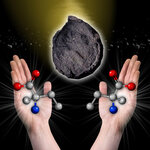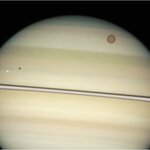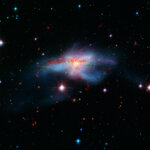Space

Phobos and Deimos are just two of many moons of the solar system. Meet Deimos in color as viewed by the Mars Reconnaissance Orbiter on 21 February 2009.
And here is Phobos image taken by the same spacecraft on 23 March 2008.
These two tiny moons of Mars are alleged to be captured asteroids originating near or far reaches of the solar system. The larger moon, Phobos, orbits so close to Mars that it is probably doomed to be shattered by gravitational tidal forces sooner than Deimos.
Let's review some of Phobos and Deimos parameters, respectively, to appreciate the…

Alert! Voting starts today with NASA's goofy but fun Launch Madness brackets, mimicking sports' March Madness. A bit ironic given I'd just written on how voting does not make science. That said, choose your favorite missions and see how your vote stacks up!
mission-madness.nasa.gov (Warning: Flash required)
Good luck with the acronyms. I had to check to see MER was the Mars rovers, Spirit and Opportunity. I predict that anything marked STS-# will not do well, as it's harder for "just another shuttle mission" to compete with a focused mission that also has a catchy name.
My long-term bet,…

Where do supernovae come from?
It depends on who you ask. Astronomers know they were exploding stars but there was always more to the story. Researchers from the Dark Cosmology Centre at the Niels Bohr Institute, University of Copenhagen and from Queens University, Belfast say dying red supergiant stars can also produce supernovae.
If you don't already know, a star is essentially a large ball of hot gas and in its incredibly hot interior hydrogen atoms combine to form helium, which subsequently forms carbon, other heavier elements and finally iron. When all the atoms in the…

I'll admit I'm a Plutophile. Whether it's called a planet or not, it's a very interesting place. Yet despite sending New Horizons to visit it (fastest launch ever!), despite the discovery of other Kuiper Belt objects, one facet of Pluto continues to dominate the news. Is it a planet? As it turns out, there are things far more important to consider about Pluto than its planethood status.
The recap: Pluto, deemed a Planet since its discovery in 1930, got 'demoted' to 'dwarf planet' by the International Astronomical Union (IAU) in 2006. That decision was controversial. Alan Stern, principal…

NASA scientists analyzing the dust of meteorites say they have discovered new clues to a long-standing mystery about how life works on its most basic, molecular level.
Over the last four years, the team carefully analyzed samples of meteorites with an abundance of carbon, called carbonaceous chondrites. The researchers looked for the amino acid isovaline and discovered that three types of carbonaceous meteorites had more of the left-handed version than the right-handed variety – as much as a record 18 percent more in the often-studied Murchison meteorite.
"We found more support for the…

The Hubble Space Telescope recently captured a photo sequence of four moons of Saturn passing in front of their parent planet. The moons, from far left to far right, are icy white Enceladus and Dione, the large orange moon Titan, and icy Mimas. Due to the angle of the Sun, they are each preceded by their own shadow.
These rare moon transits only happen when the tilt of Saturn's ring plane is nearly "edge on" as seen from the Earth. Saturn's rings will be perfectly edge on to our line of sight on 10 August and 4 September 2009. Unfortunately, Saturn will be too close to the Sun to be seen by…

Maybe ESA’s Gravity field and steady-state Ocean Circulation Explorer (GOCE) is destined to launch on the exact same date as Vanguard 1, the third artificial satellite to ever orbit our planet after Sputnik and Explorer 1. On March 17th 1958 Vanguard 1 was successfully launched and as a matter of fact the satellite is still orbiting our planet as today's longest 'living' satellite ever.
It would make sense that GOCE joined Vanguard 1 in orbit on this exact date since the major scientific motivation and results from Vanguard 1 are geodetic. Vanguard 1 confirmed geodestists educated opinion…

Want to see a collision between the cores of two merging galaxies, each powered by a black hole with a millions of times the mass of the sun?
You're in luck. NASA's Spitzer Space Telescope recently caught that very thing. The galactic cores are in a single, tangled galaxy called NGC 6240, located 400-million light years away in the constellation Ophiuchus. Millions of years ago, each core was the dense center of its own galaxy before the two galaxies collided and ripped each other apart. Now, these cores are approaching each other at tremendous speeds and preparing for the…

Sometimes different is good. You may not want a strange cup of coffee when you go to Starbucks and you would like for your car to work the way cars should, but in science the peculiar can teach us a lot. This was the idea behind Halton Arp’s catalogue of Peculiar Galaxies that appeared in the 1960s. One of the oddballs listed there is Arp 261, which has now been imaged in more detail than ever before using the FORS2 instrument on ESO’s Very Large Telescope.
Arp 261 lies about 70 million light-years distant in the constellation of Libra, the Scales. Its chaotic and very unusual…

Our website got hacked. Astronomy sites are a popular target. It's safer to hack NASA than, say, the NSA. All the bragging but little of the risks.
Hacking NASA to get at 'inside stuff' is generally pointless. The whole purpose of NASA is to publically deliver what we do. All the good data and the best software gets openly released. Trying to hack NASA is like stealing twenty copies of the free local newspaper off the delivery truck. It's not only illegal, it's stupid, doesn't gain you anything, and takes more work then getting it the legit way.
One of our web guys posits that it's easy…